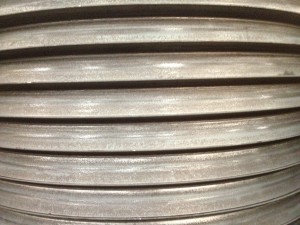On July 31, with little time in her busy schedule, Jeanne told me, “Just show me the good stuff.” I skipped the Power Point presentation and headed directly for the section bender where her crew was videotaping the rolling of 1-1/2, 2, 2-1/2, and 3inch pipe into rings varying in diameter from 6 to 18ft. The pipe rings are for an exhibition opening at the Art Institute of Chicago on September 22, the first in the world documenting the award-winning work of her firm, Studio Gang Architects. The video of the steel fabrication will be part of the exhibit itself.
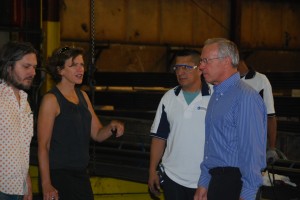
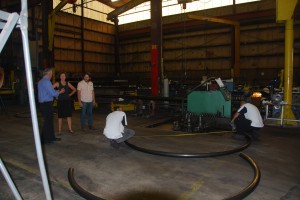
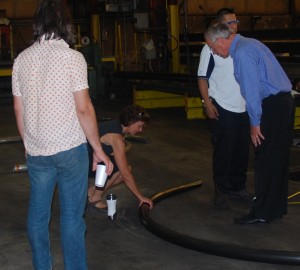
On a shop tour, Jeanne exhibited an intense curiosity about materials. She gravitated toward some three-inch-diameter aluminum pipe that had cracked during our experimental testing of aluminum elongation. She was fascinated by how they broke: some revealed greater elongation before tensile failure. We had been bending a variety of tempers—T6, T4 and zero temper. Jeanne has said that “sometimes you have to break it to make it.” We discovered that some tempers were too brittle and some were too soft.
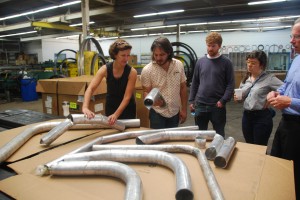
Although not exactly dressed for working in a metal fabrication shop, Jeanne was literally not afraid to get her hands dirty, inspecting many curved steel objects in our plant. She saw some heavy tightly curved leg-in angle rings and was impressed that the leg in had not rippled even to the touch.She witnessed angles, bars, beams and channels being curved on three-roll benders.
She and her colleagues peppered us with questions. What’s that machine? Answer: a press brake with radius dies for curving steel bars. What’s that? a rotary draw bender using an internal mandrel to bend rectangular tubing. And that old machine? That was build by my grandfather some 80 years ago. It’s been upgraded and can roll some sections better than the modern machines we have. What’s that big machine? That’s a plate roll that formed these large cones. How do you do a compound bend? Answer: Very carefully. (We’re not going to tell you all our secrets.)
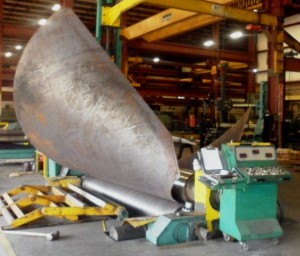
Her fellow architects went into what seemed like a steel teepee or one of Richard Serra’s works of art. The parts will actually be used in a scrubber system to reduce emissions from a power plant by up to 90%.
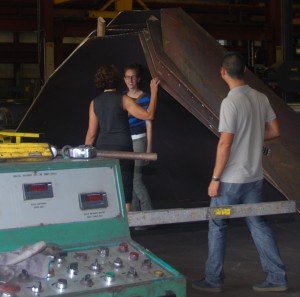
As we moved past some smaller cones bump formed on a press brake, the Studio Gang group was surprised to see in the next bay a 24in wide flange beam rolling by. On one of our larger section benders, we were curving the steel member to a tight 6ft center line radius. I said, honestly, that rolling that section the “easy way,” i.e. against the weak axis, was actually easy for us with the right equipment, operator and process.
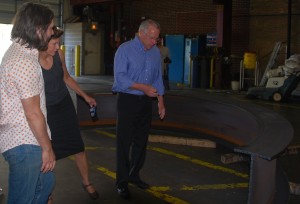
Next, Jeanne was intrigued by the process of curving beams “the hard way” i.e. against the strong axis, and how our machines keep the web of the beams from crippling: while three large rolls induce the curve with compressive force, two small rolls pull on the outside flanges to keep the web in tension.
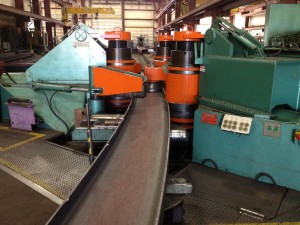
If much of this technology was new to Jeanne Gang and her associates, their architectural perspective was new to us. For example, one architect looked at our tooling to curve 24in pipe and said one of those would make a great table in his apartment. (A rather expensive table too.)
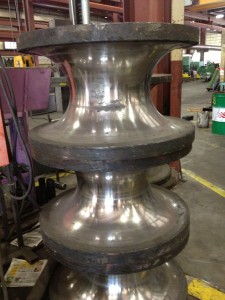
To another, a stack of angle rings appeared as a beautiful monolithic structure instead of some 20 flanges used to connect pipe for a smokestack. Other materials created patterns and textures that caught their eyes.
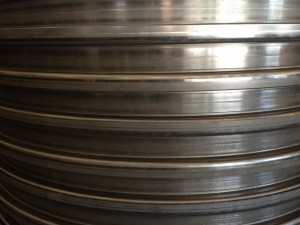
One aspect of all Jeanne Gang’s work is her profound fascination with material: “It is the one who is thoroughly curious about a material who has the potential to instill it with surprising traits. This is because surprise is dependent upon discovery; discovery on experimentation; experimentation to some degree upon chance; and chance on a willingness to fail.” That intense curiosity was abundantly evident during Gang’s visit to Chicago Metal Rolled Products. And it was infectious not only for her associates but also for those in our company who witnessed her unabashed enthusiasm. I guess what I showed her was “the good stuff.”

